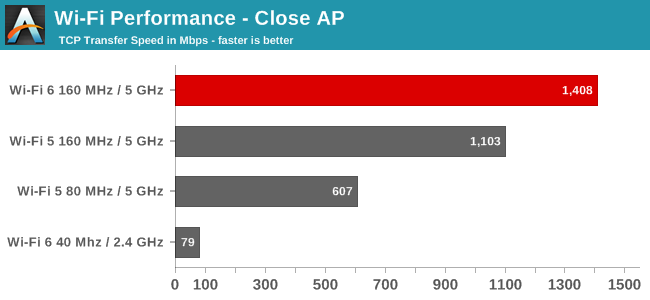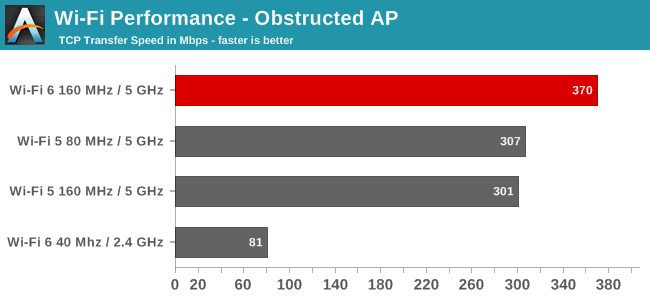AT 101: Wi-Fi 6 And Why You Want It
by Brett Howse on February 12, 2020 8:00 AM ESTPerformance
In order to achieve maximum performance, the latest Wi-Fi 6 standard leverages 1024-level QAM, but depending on the signal strength and quality it will scale down as needed, so to achieve the best performance very high signal to noise ratios are going to be required. Since 5 GHz is attenuated dramatically when it has to go through walls, if you need maximum Wi-Fi performance be aware that you are going to want your wireless router as close to the end device as possible. Luckily that is not an issue in our case, since the router is in the same room when testing for maximum performance, but we’ll also evaluate it in less than ideal scenarios as well.
Wi-Fi 5 vs Wi-Fi 6 – Close AP
First up we’ll test the TCP performance when the Access Point is in the same room as the client.

The performance advantages of Wi-Fi 6 are clear. With the access point in the same room, the SNR is very good and the new 802.11ax standard can really shine. With 1024 QAM and 160 MHz channels, the performance is over twice as fast as the outgoing Wi-Fi 5 with 256 QAM and 80 MHz channels. It is very impressive to see a typical 2x2:2 connection well over the Gigabit barrier, and even though the AX200 network card is the first generation, Intel has already done a fantastic job tuning it. The theoretical maximum transfer rate with 160 MHz channels and 1024 QAM is around 1200 Mbps per connection, so a 2x2 can in theory hit around 2.4 Gbps, meaning there's still room for improvement. Since 802.11ax also can be used on the 2.4 GHz frequency, unlike 802.11ac, the same test was also done on 2.4 GHz, and the results were disappointing. 2.4 GHz can still offer 40 MHz channels, but it doesn’t seem like the AX200 could take advantage of any of that. For reference, the wireless adapter in the laptop was reporting -21 dBm, which is a strong signal, which makes sense since the AP is almost right next to the laptop.
Wi-Fi 5 vs Wi-Fi 6 – Reduced Signal
Moving the laptop further away, and adding several walls and doors in the way to attenuate the signal, the same scenarios were again tested.

With some walls in the way, 5 GHz gets attenuated quite dramatically, and the SNR in the second location was -78 dBm. With such a low signal, the Wi-Fi 6 connection wasn’t able to take advantage of the 1024-level QAM and would have had to drop down to a much lower set, reducing the number of bits per tone, and even though the total channel bandwidth was still 160 MHz, it was only marginally faster on 802.11ax than 802.11ac 80 MHz. 2.4 GHz is not as impacted by walls, and as such was able to maintain the same transfer rate, even though it was still quite a bit slower.
So the results are clear. Wi-Fi 6 can offer a significantly higher level of throughput than Wi-Fi 5, but in order to do so, it needs a strong signal. The Wi-Fi 6 still outperformed the Wi-Fi 5 in the second test with an attenuated signal, but the performance gain was minimal. 2.4 GHz still offers the best signal strength, and therefore would be able to connect further away, and through more obstacles, but doesn’t offer anywhere near the performance of the 5 GHz range. It will be interesting to see the Wi-Fi 6E devices with 6 GHz support when they launch. It will open up Wi-Fi to a wider set of frequency choices, but will offer even less range.










149 Comments
View All Comments
TheUnhandledException - Friday, February 14, 2020 - link
Wired (copper) is already capable of 10 Gbps and 40 Gbps speed. Fiber even more than that. Let me know when wifi can do 40 Gbps or even 10 Gbps. Not in a lab but real world with congestion from neighbors wasting bandwidth running their inefficient 802.11b/g devices.GreenReaper - Friday, February 14, 2020 - link
Hint: If it's in the air, it's not a fibre. Such fibres are also known as cables. "Air fiber" doesn't exist.If you're the *only* person using a wireless connection, you may achieve a reasonable fraction of its maximum performance - in one direction. But it doesn't come close to what you can get wired. The real question is whether you are willing to pay for that performance. Most consumers don't need to, and therefore consume kit doesn't have it. When there is a need for it, it'll be available, because as others mentioned the capability is there - and it has been for over a decade.
Makaveli - Friday, February 14, 2020 - link
lol there is always someone like this.Keep on dreaming.
syleishere - Thursday, February 13, 2020 - link
Also remember phone lines and cable lines are on their way out. I'd be looking into Elon Musk satellite project starlink and the cell phone companies 5G networks for fastest internet over next few years. Remember air is faster, more spectrums can be used than you can get on a wired connection. I'd keep them around anyways, I prefer gaming on wired especially when raiding in ff14, but wireless one day will be the way to download those 50gb files for your 8k TV on torrents faster so keep that in mind. Air is faster, wired from phone lines and cable lines will be slower.Whiteknight2020 - Thursday, February 13, 2020 - link
"air is faster"Except when there's
Cloud
Rain
Snow
Pollution
EM interference
Congestion
Solar flares
Unlike a completely unobstructed piece of glass or copper. Which, oddly,is why we hook up all our critical stuff with.... Copper & glass.
Korguz - Friday, February 14, 2020 - link
syleishere...yea ok sure.. could you share what ever it is you are on.. so the rest of us can believe the same nonsense you do ?
GreenReaper - Friday, February 14, 2020 - link
Both mediums have their place. Wireless's place is in the kitchen - not gaming or the datacenter.Hyper72 - Saturday, February 15, 2020 - link
Indeed, it's all about use case and environment. I got an Asus RT-AX88U last year and have been gaming a lot over WiFi. It's rock solid, never a single disconnect and latency to the router is sub 1ms - all significant latency for gaming is further out in the network. I couldn't say the same about my old Netgear R7000.I also get ~100MB/s from my NAS which is great for the work I do at home.
peevee - Thursday, February 13, 2020 - link
If only a few major countries would open up more channels close to 2.4 (below 2.4 or above 2.5), we could have had the best of both worlds - performance and range. Who is hoarding 2.5-3GHz range for example?TheUnhandledException - Friday, February 14, 2020 - link
Below 2.4 GHz is a number of military bands. In the US above 2.5 GHz (well above 2.495 GHz) is the cellular band allocated to Sprint (now T-Mobile after the merger). I don't see the 2.4 GHz ISM band (which is what wifi uses) getting expanded.